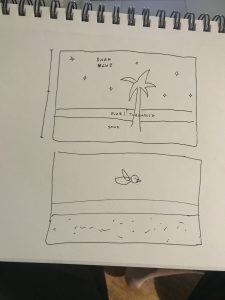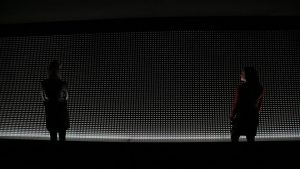var trees = [];var bushes = []; var speed = 0.00001;
function setup() {
createCanvas(480, 480);
for (var t = 0; t < 5; t++){
var tx = random(width);
trees[t] = makeTree(tx);
var bx = random(width);
bushes[t] = makeBush(bx);
}
frameRate(10);}
function makeTree(tx) {
var trees = {x: tx,
draw: treeDraw}
return trees;
}
function makeBush(bx) {
var bushes = {x: bx,
draw: bushDraw}
return bushes;
}
function treeDraw() {
noStroke();
fill(14, 90, 117);
triangle(this.x - 20, 398, this.x + 20, 398, this.x, 320);
stroke(13, 77, 94);
line(this.x, 330, this.x, 400);
this.x -= 1;
var newTree = 0.0025; if (random(0, 1) < newTree) {
trees.push(makeTree(width + 20)); }
}
function bushDraw() {
noStroke();
fill(28, 65, 72);
triangle(this.x - 15, 403, this.x + 15, 403, this.x, 330);
stroke(13, 77, 94);
line(this.x, 340, this.x, 405);
this.x -= 1.2;
var newBush = 0.0025; if (random(0, 1) < newBush) {
bushes.push(makeBush(width + 15)); }
}
function draw() {
background(228, 239, 242);
noStroke();
for (var y = 100; y < 400; y++) { var a = map(y, 100, 400, 0, 255); stroke(240, 178, 158, a);
line(0, y, width, y); }
fill(240, 178, 158);
ellipse(240, 200, 25);
beginShape();
stroke(149, 189, 207);
var variance1 = 0.001;
for (i = 0; i < width; i++) {
var t = (i * variance1) + (millis() * speed);
var y = map(noise(t), 0, 1, 100, height);
line(i, y, i, height);
}
endShape();
for (var y = 200; y < 400; y++) {
var b = map(y, 200, 400, 0, 255);
stroke(187, 208, 214, b);
line(0, y, width, y);
}
beginShape();
stroke(85, 170, 200);
var variance2 = 0.0015;
for (j = 0; j < width; j++) {
var t = (j * variance2) + (millis() * speed);
var y = map(noise(t), 0, 1, 150, height);
line(j, y, j, height);
}
endShape();
for (var y = 200; y < 480; y++) {
var b = map(y, 200, 480, 0, 255);
stroke(187, 208, 214, b);
line(0, y, width, y);
}
for (var u = 0; u < trees.length; u++) {
trees[u].draw();
}
for (var y = 350; y < 480; y++) {
var b = map(y, 350, 480, 0, 255);
stroke(187, 208, 214, b);
line(0, y, width, y);
}
noStroke();
fill(117, 144, 139);
rect(-1, 400, width + 1, 10);
fill(63, 84, 77);
rect(-1, 405, width + 1, 80);
for (var v = 0; v < bushes.length; v++) {
bushes[v].draw();
}
var treesToKeep = [];
for (var i = 0; i < trees.length; i++){
if (trees[i].x + 20 > 0) {
treesToKeep.push(trees[i]);
}
}
trees = treesToKeep;
var bushesToKeep = [];
for (var v = 0; v < bushes.length; v++){
if (bushes[v].x + 20 > 0) {
bushesToKeep.push(bushes[v]);
}
}
bushes = bushesToKeep;
}
I enjoyed this project, even though I initially struggled a lot with what kind of landscape I wanted to do. I wanted to make a landscape that looked believable, and since we basically all only had one terrain generation template, it was hard for me to pick a landscape I felt like I could create and be satisfied with. I ended up looking through landscape photos and using one for inspiration and reference. It was really helpful to be able to pull colors from the photo, as well as realistic landscape qualities.
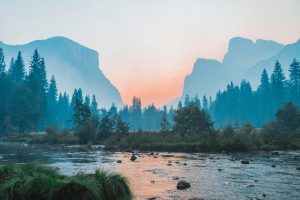
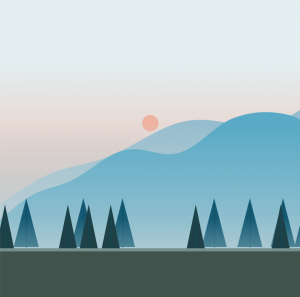
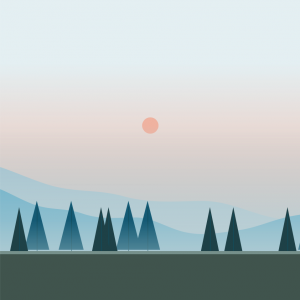
I’m pretty proud with how my landscape turned out, especially with the fog (which I learned how to code alpha gradients for). I really want to try using this kind of concept to generate backgrounds that could be used for games or for open-world environments. I might explore some of that in the future (maybe for my final project?).
![[OLD FALL 2018] 15-104 • Introduction to Computing for Creative Practice](../../../../wp-content/uploads/2020/08/stop-banner.png)
